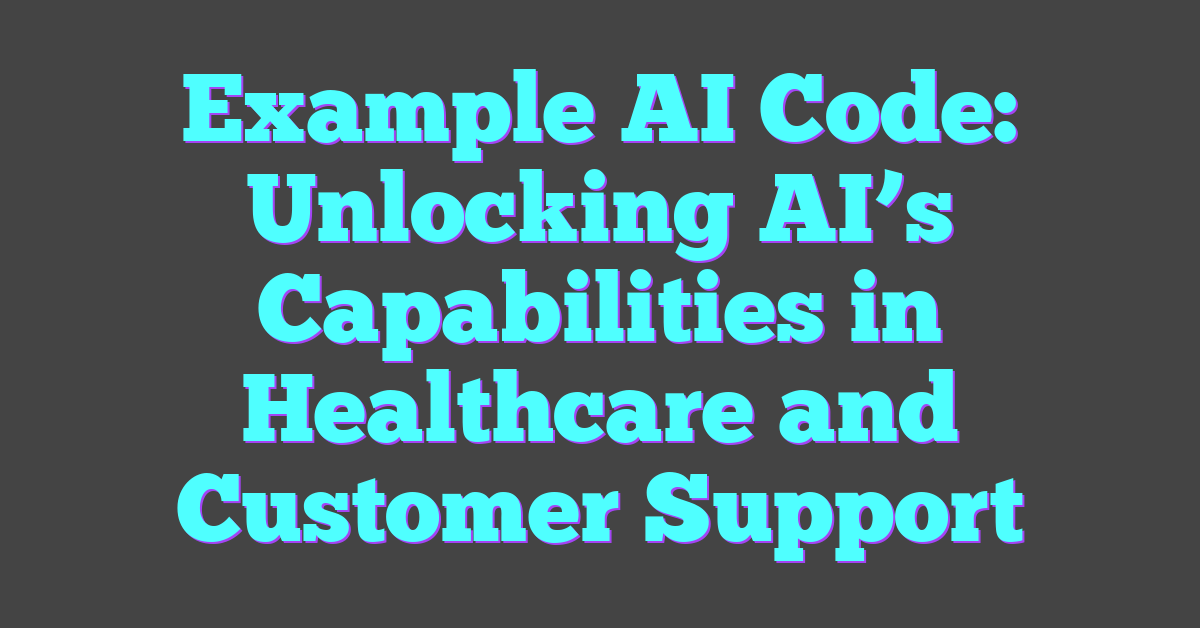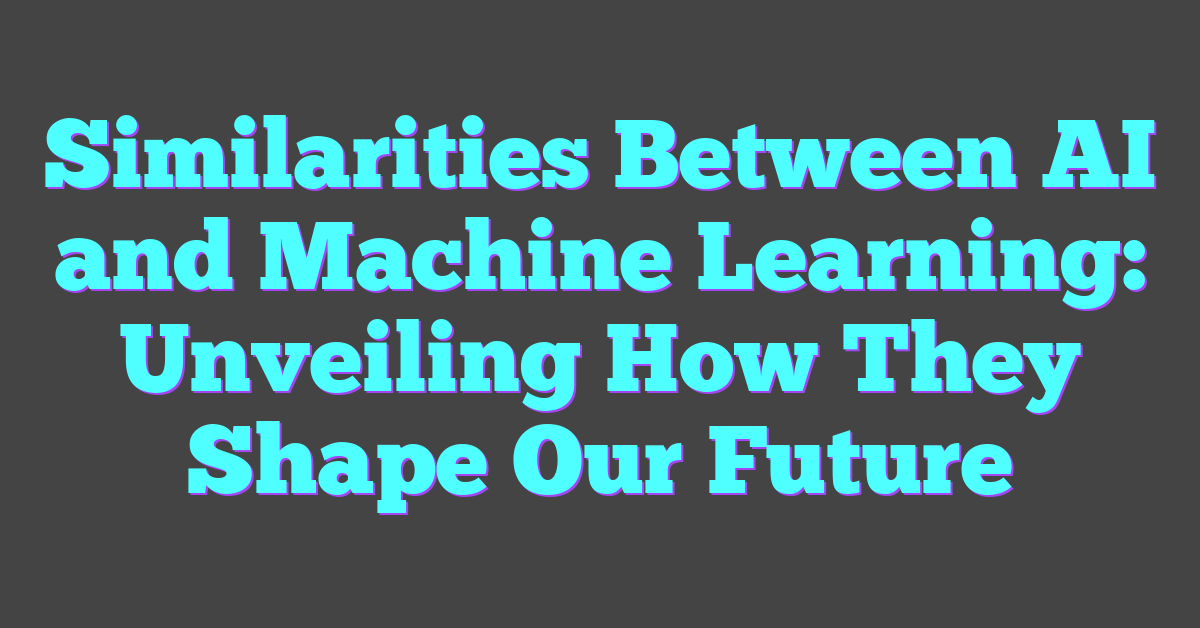Artificial Intelligence (AI) is no longer a concept confined to science fiction; it’s now an integral part of our daily lives. From virtual assistants like Siri and Alexa to recommendation engines on Netflix, AI is everywhere, making our lives easier and more efficient. But have you ever wondered how these intelligent systems are created?
Diving into AI might seem daunting, but it all starts with understanding some basic examples of AI code. Whether you’re an experienced programmer or a curious beginner, exploring these examples can provide valuable insights into the world of AI. Let’s take a look at how simple lines of code can transform into powerful, intelligent applications.
Exploring Example AI Code
Understanding simple examples of AI code enables individuals to grasp the basics of how AI functions. These examples serve as practical tools for learning and experimenting with complex concepts.

What Is Example AI Code?
Example AI code consists of pre-written segments demonstrating fundamental AI algorithms or processes. Typically, these include basic implementations of functions like regression, classification, clustering, and neural networks. For instance, a snippet showcasing a decision tree classifier written in Python’s scikit-learn library is an example of AI code. Code blocks often contain comments explaining each step, making it easier for learners to follow.
Why It Matters
Example AI code plays a significant role in learning and development. By studying these examples, novices gain insights into AI algorithms, while experienced coders refine their skills. Practical code illustrations translate abstract theories into understandable actions. They also help in debugging and optimizing real-world applications, offering a priceless educational resource.
Key Components of Effective AI Code
Effective AI code merges essential components to ensure robust, efficient, and accurate machine learning solutions. These components, when properly implemented, streamline the development process and enhance performance.
Algorithms and Data Structures
Algorithms and data structures form the backbone of AI code. Selecting the right algorithm, whether for regression, classification, clustering, or neural networks, directly influences an AI system’s effectiveness. Commonly used algorithms include linear regression, decision trees, k-means clustering, and convolutional neural networks (CNNs).
Data structures like arrays, hash tables, and trees facilitate efficient data manipulation and retrieval. Example: a hash table improves data lookup times in large datasets, essential for real-time applications. Proper use of algorithms and data structures can significantly optimize processing speeds and reduce memory usage.
Debugging and Optimization Techniques
Debugging and optimization techniques are pivotal in refining AI code. Debugging identifies and resolves errors that hinder performance. Techniques such as breakpoints, logging, and unit tests assist in isolating and fixing issues efficiently. Example: using TensorFlow’s debugging tools helps locate and rectify errors in neural network training.
Optimizing AI code enhances its efficiency and accuracy. Methods include hyperparameter tuning, which adjusts parameters like learning rates and batch sizes, and code profiling, which identifies bottlenecks. Example: using tools like PyTorch Profiler to streamline model performance by optimizing computational graphs and reducing execution times.
Effective AI code leverages suitable algorithms, data structures, debugging, and optimization techniques to ensure optimal performance and accuracy.
Review of Popular AI Coding Tools and Libraries
Several coding tools and libraries assist developers in creating robust AI solutions. He analyzes the most popular ones to offer insights into their features and benefits.
TensorFlow and PyTorch
TensorFlow, developed by Google Brain, stands out for its scalable architecture, allowing easy model deployment across different platforms. This library supports both high-level and low-level APIs, making it suitable for beginners and advanced users. Its powerful visualization tool, TensorBoard, aids in monitoring and debugging models efficiently. TensorFlow also offers TensorFlow Lite for mobile and embedded devices, enhancing its versatility.
PyTorch, created by Facebook’s AI Research lab, is favored for its intuitive, dynamic computation graph. This feature facilitates real-time, flexible model building and debugging. PyTorch integrates seamlessly with Python, enhancing its accessibility for developers. Its robust library, TorchVision, provides tools for computer vision tasks, while PyTorch’s support for GPU acceleration ensures fast and efficient model training.
Scikit-Learn and Keras
Scikit-Learn, an efficient and easy-to-use library for machine learning, excels in data mining and data analysis. It offers a range of algorithms for classification, regression, clustering, and dimensionality reduction. Scikit-Learn integrates well with other Python libraries like NumPy and pandas, making it highly compatible for comprehensive analysis procedures. Its simple interface promotes rapid prototyping without compromising performance.
Keras, known for its user-friendly API, simplifies the building and training of neural networks. Integrated tightly with TensorFlow, Keras supports both convolutional and recurrent networks, making it ideal for complex tasks. Its modular nature allows easy extension, enabling customization according to specific needs. Keras also provides robust support for multiple backend engines, adding to its flexibility as a deep learning framework.
Through these tools and libraries, developers can leverage powerful AI techniques to create innovative and effective machine learning models.
Implementation Challenges and Solutions
Developing AI models comes with its own set of challenges and solutions. Addressing these issues requires an understanding of both theoretical and practical aspects of AI.
Handling Large Datasets
AI models often involve large datasets which pose significant challenges in terms of storage, processing, and management. High-quality datasets are crucial for training robust models. They need to be stored efficiently; consider using distributed file systems like Hadoop Distributed File System (HDFS).
- Data Preprocessing: Techniques like normalization, scaling, and augmentation ensure data quality. Consistent formats eliminate discrepancies and improve model performance.
- Distributed Computing: Tools like Apache Spark and TensorFlow’s tf.data API enable the processing of large datasets across multiple nodes. These tools offer scalable solutions for handling data-intensive tasks.
Ensuring Model Accuracy
Implementing AI models that deliver high accuracy is fundamental for reliable predictions. Various strategies enhance model accuracy, addressing issues such as overfitting and underfitting.
- Hyperparameter Tuning: Adjusting parameters like learning rate, batch size, and the number of layers optimizes model performance. Scikit-Learn and Keras provide easy-to-implement hyperparameter tuning techniques.
- Cross-Validation: Splitting the dataset into training and validation sets ensures that the model generalizes well to unseen data. K-fold cross-validation is a popular method for validating model accuracy.
- Effective Algorithms: Incorporating advanced algorithms like Gradient Boosting and Convolutional Neural Networks (CNNs) enhances the model’s predictive capabilities. Use frameworks like XGBoost and PyTorch to implement these algorithms seamlessly.
Real-World Applications of AI Code
Artificial Intelligence (AI) code impacts several sectors today by automating tasks and generating predictive insights. AI serves as a catalyst for advancing technologies in areas like healthcare and customer support, transforming operations and enhancing user experiences.
Healthcare Predictions
AI significantly contributes to predictive models in healthcare, aiding in early diagnosis and treatment plans. Machine learning algorithms analyze patient data (like MRI scans, EHRs) to predict disease onset. For example, deep learning models (e.g., Convolutional Neural Networks) identify patterns in medical imaging, flagging anomalies like tumors. AI-powered tools also forecast patient readmission risks, enabling healthcare providers to allocate resources effectively.
Automated Customer Support
AI optimizes customer service by automating responses and managing routine inquiries. Chatbots and virtual assistants, like those using Natural Language Processing (NLP) algorithms, understand and resolve customer queries promptly. AI systems, for instance, classify support tickets by urgency, ensuring faster resolution. Sentiment analysis tools assess customer emotions in real-time, facilitating more empathetic interactions and enhancing overall customer satisfaction.
Conclusion
Exploring example AI code is an invaluable step for anyone looking to understand the core principles of artificial intelligence. It provides a hands-on approach to learning, from basic algorithms to complex model optimizations. With tools like TensorFlow and PyTorch, even the most daunting tasks become manageable.
Overcoming challenges such as handling large datasets and fine-tuning models is crucial for successful AI implementation. Real-world applications in sectors like healthcare and customer support highlight the transformative power of AI. Whether it’s predicting medical outcomes or enhancing customer interactions, AI code is revolutionizing various industries.
Diving into AI coding not only equips one with technical skills but also opens up endless possibilities for innovation and problem-solving in today’s tech-driven world.
Frequently Asked Questions
Why is studying example AI code important?
Studying example AI code is crucial as it helps you understand AI fundamentals, algorithms, data structures, debugging, and optimization techniques. It allows you to see how theoretical concepts are applied in practical scenarios.
What are some popular AI coding tools?
Popular AI coding tools include TensorFlow, PyTorch, Scikit-Learn, and Keras. These tools provide robust frameworks and libraries for developing and implementing AI models.
How can one handle large datasets efficiently in AI?
Efficient handling of large datasets in AI can be achieved using tools like Apache Spark and TensorFlow’s tf.data API. These tools help in scaling and managing big data effectively.
What are key data preprocessing techniques in AI?
Key data preprocessing techniques involve cleaning, normalizing, and transforming data. This ensures that the dataset is structured correctly for training accurate AI models.
How can distributed computing aid in AI model implementation?
Distributed computing allows AI model training to be spread across multiple machines, reducing processing time and efficiently handling large datasets. This is essential for developing scalable and performant AI systems.
Why is hyperparameter tuning important for AI models?
Hyperparameter tuning is important as it helps in optimizing the AI model’s performance. By adjusting parameters like learning rates and batch sizes, you can enhance model accuracy and effectiveness.
What are real-world applications of AI in healthcare?
In healthcare, AI is used in predictive models for early diagnosis and treatment plans. Machine learning algorithms and deep learning models like Convolutional Neural Networks support these advancements.
How does AI improve customer support services?
AI improves customer support by automating responses, deploying chatbots, and using sentiment analysis tools. This optimizes service efficiency and enhances customer satisfaction by providing quicker, more accurate support.



